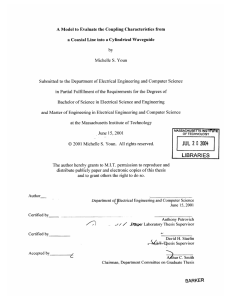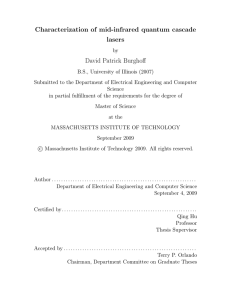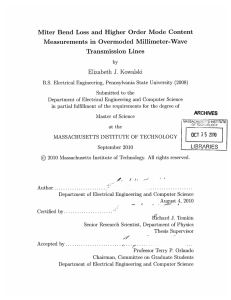18.325 Problem Set 2
advertisement
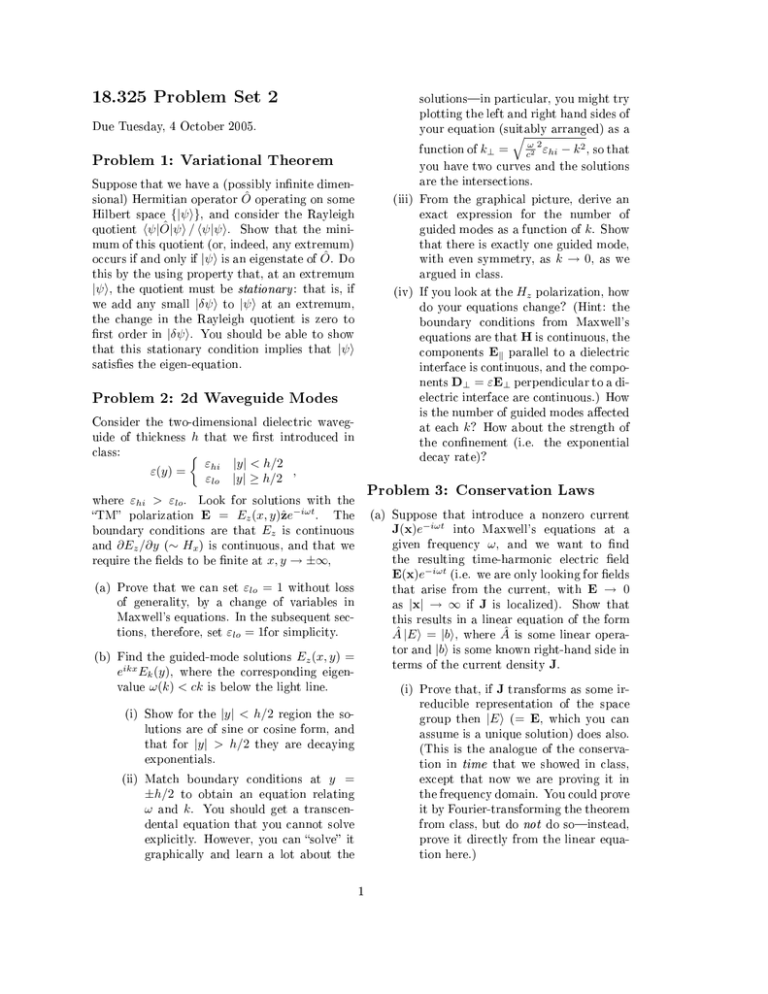
18.325 Problem Set 2
solutionsin particular, you might try
plotting the left and right hand sides of
your equation (suitably
arranged) as a
q
Due Tuesday, 4 October 2005.
function of k⊥ = cω2 2 εhi − k 2 , so that
you have two curves and the solutions
are the intersections.
(iii) From the graphical picture, derive an
exact expression for the number of
guided modes as a function of k . Show
that there is exactly one guided mode,
with even symmetry, as k → 0, as we
argued in class.
(iv) If you look at the Hz polarization, how
do your equations change? (Hint: the
boundary conditions from Maxwell's
equations are that H is continuous, the
components Ek parallel to a dielectric
interface is continuous, and the components D⊥ = εE⊥ perpendicular to a dielectric interface are continuous.) How
is the number of guided modes aected
at each k ? How about the strength of
the connement (i.e. the exponential
decay rate)?
Problem 1: Variational Theorem
Suppose that we have a (possibly innite dimensional) Hermitian operator Ô operating on some
Hilbert space {|ψi}, and consider the Rayleigh
quotient hψ|Ô|ψi / hψ|ψi. Show that the minimum of this quotient (or, indeed, any extremum)
occurs if and only if |ψi is an eigenstate of Ô. Do
this by the using property that, at an extremum
|ψi, the quotient must be stationary : that is, if
we add any small |δψi to |ψi at an extremum,
the change in the Rayleigh quotient is zero to
rst order in |δψi. You should be able to show
that this stationary condition implies that |ψi
satises the eigen-equation.
Problem 2: 2d Waveguide Modes
Consider the two-dimensional dielectric waveguide of thickness h that we rst introduced in
class:
½
εhi |y| < h/2
ε(y) =
,
εlo |y| ≥ h/2
Problem 3: Conservation Laws
where εhi > εlo . Look for solutions with the
TM polarization E = Ez (x, y)ẑe−iωt . The
boundary conditions are that Ez is continuous
and ∂Ez /∂y (∼ Hx ) is continuous, and that we
require the elds to be nite at x, y → ±∞,
(a) Suppose that introduce a nonzero current
J(x)e−iωt into Maxwell's equations at a
given frequency ω , and we want to nd
the resulting time-harmonic electric eld
E(x)e−iωt (i.e. we are only looking for elds
that arise from the current, with E → 0
as |x| → ∞ if J is localized). Show that
this results in a linear equation of the form
 |Ei = |bi, where  is some linear operator and |bi is some known right-hand side in
terms of the current density J.
(a) Prove that we can set εlo = 1 without loss
of generality, by a change of variables in
Maxwell's equations. In the subsequent sections, therefore, set εlo = 1for simplicity.
(b) Find the guided-mode solutions Ez (x, y) =
eikx Ek (y), where the corresponding eigenvalue ω(k) < ck is below the light line.
(i) Prove that, if J transforms as some irreducible representation of the space
group then |Ei (= E, which you can
assume is a unique solution) does also.
(This is the analogue of the conservation in time that we showed in class,
except that now we are proving it in
the frequency domain. You could prove
it by Fourier-transforming the theorem
from class, but do not do soinstead,
prove it directly from the linear equation here.)
(i) Show for the |y| < h/2 region the solutions are of sine or cosine form, and
that for |y| > h/2 they are decaying
exponentials.
(ii) Match boundary conditions at y =
±h/2 to obtain an equation relating
ω and k . You should get a transcendental equation that you cannot solve
explicitly. However, you can solve it
graphically and learn a lot about the
1
(ii) Formally, |Ei = Â−1 |bi, where Â−1 is
related to the Green's function of the
system. What happens if ω is one of
the eigenfrequencies?
nd them tabulated). Sketch the dispersion
relation ω(k) for a few bands.
(c) From the general orthogonality of Hermitian
eigenfunctions, derive an orthogonality integral for the Bessel functions.
(b) Let Ût be our time-evolution operator, and
we have some space group G of symmetry
operators Ôg (g ∈ G) such that [Ût , Ôg ] = 0.
Now, suppose that we have some state |ψ(t)i
that at one time transforms as purely one
representation and at a later time transforms as some other representation (or some
superposition of representation), violating
the conservation theorem we proved in class.
Show that this implies that Ût is a nonlinear
operator (i.e. it depends on the amplitude of
the state). (In class, we implicitly assumed
that our operators were linear.)1
Problem 5: Numerical computations with MPB
For this problem, you will gain some initial experience with the MPB numerical eigensolver described in class, and which is available on Athena
in the mpb locker. Refer to the class handouts, and also to the online MPB documentation at jdj.mit.edu/mpb/doc. For this problem,
you will study the simple 2d dielectric waveguide (with εhi = 12) that you analyzed analytically above, along with some variations thereof
start with the sample MPB input le (2dwaveguide.ctl) that was introduced in class and is available on the course web page.
Problem 4: Cylindrical symmetry
Suppose that we have a cylindrical metallic
waveguidethat is, a perfect metallic tube with
radius R, which is uniform in the z direction.
The interior of the tube is simply air (ε = 1).
(a) Plot the TM (Ez ) even modes as a function
of k , from k = 0 to a large enough k that
you get at least four modes. Compare where
these modes start being guided (go below
the light line) to your analytical prediction
from problem 1. Show what happens to this
crossover point when you change the size
of the computational cell.
(a) This structure has continuous rotational
symmetry around the z axis, called the C∞
group.2 Find the irreducible representations
of this group (there are innitely many because it is an innite group).
(b) Plot the elds of some guided modes on a
log scale, and verify that they are indeed exponentially decaying away from the waveguide. (What happens at the computational
cell boundary?)
(b) For simplicity, consider the (Hermitian)
2
scalar wave equation −∇2 ψ = ωc2 ψ with
ψ|r=R = 0. Show that, when we look
for solutions ψ that transform like one of
the representations of the C∞ group from
above, and have z dependence eikz (from
the translational symmetry), then we obtain a Bessel equation (Google it if you've
forgotten Mr. Bessel). Write the solutions in terms of Bessel functions, assuming that you are given their zeros xm,n (i.e.
Jm (xm,n ) = 0 for n = 1, 2, . . ., where Jm is
the Bessel function of the rst kind...if you
Google for Bessel function zeros you can
(c) Modify the structure so that the waveguide
has ε = 2.25 instead of air on the y < −h/2
side. Show that there is a low-ω cuto for
both TM and TE guided bands, as we argued in class, and nd the cuto frequency.
(d) Create the waveguide with the following
prole:
2 0 ≤ y < h/2
0.8 − h/2 < y < 0 .
ε(y) =
1 |y| ≥ h/2
1 A famous example of this in optics is third-harmonic
generation. If we have a nonlinear ε ∼ |E|2 ,we can start
with a planewave at (ω, k) and generate another wave at
(3ω, 3k).
Should this waveguide have a guided mode
as k → 0? Show numerical evidence to support your conclusion (careful: as the mode
2 It also has an innite set of mirror planes containing
the z axis, but let's ignore these for now. If they are
included, the group is called C∞v .
2
becomes less localized you will need to increase the computational cell size).
3

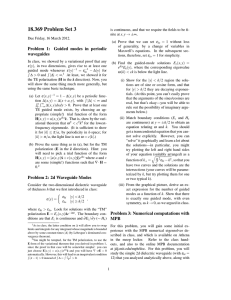
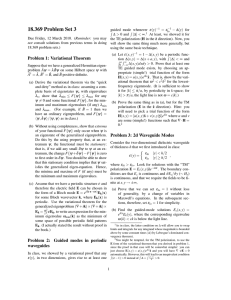
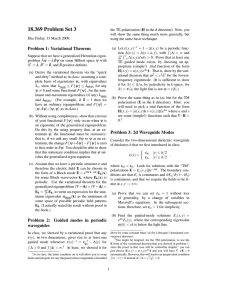
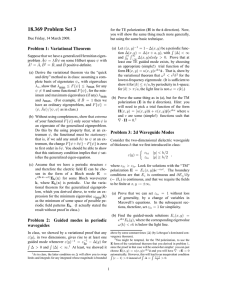
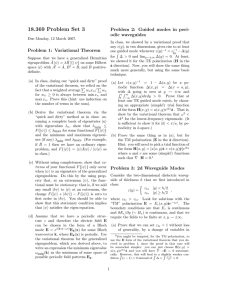
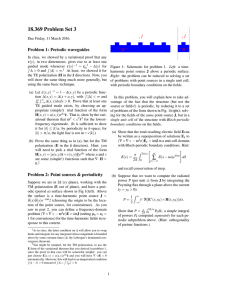

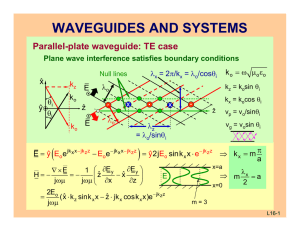


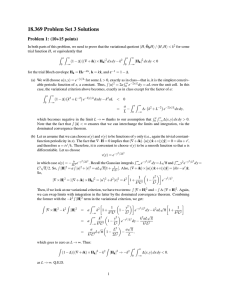




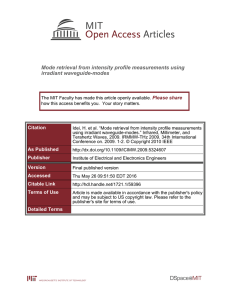
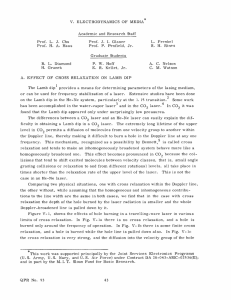
![High-efficiency second-harmonic generation in doubly- resonant [superscript (2)] microring resonators Please share](http://s2.studylib.net/store/data/012067887_1-4d20e7a132f7760a33542865e915bec7-300x300.png)
